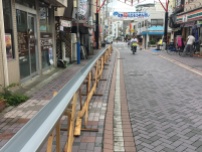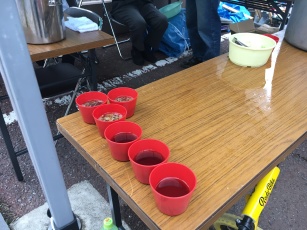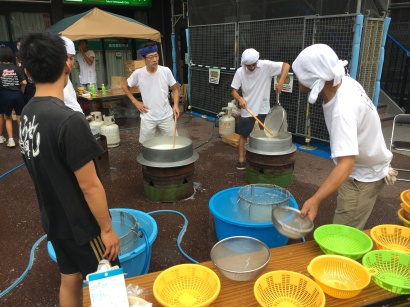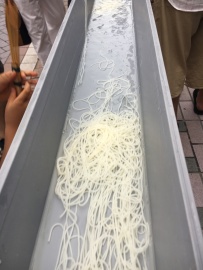Japanese love their noodles! From steaming bowls of ramen or udon, to mounds of yakisoba fresh off the griddle and dripping with tangy sauce, to bamboo trays of buckwheat soba noodles for dipping into a salty soy sauce-based soup, noodles are a dietary staple here. Not as common or well-known is somen–long, thin, wheat-based noodles, reminiscent of angel hair pasta.
In summer, these thin white noodles are sometimes served cold in small glass bowls of clear soup–topped perhaps with a dried goji berry or a small sprig of something green–, as part of the traditional meal served at a ryokan, or in a classical restaurant.
But the real summer treat featuring somen is “nagashi somen” or flowing noodles. The cooked noodles are dropped into flowing water from which the diners catch them with chopsticks and dip them into a cup of sauce similar to that used when eating soba noodles.
My first time to enjoy nagashi somen was deep in the mountains of southern Kyushu many years ago. We sat at a large stone table with a special circular trough carved into it. Water that had been diverted from a nearby stream flowed into the trough, circled the table and then out a drain. The noodles were dropped in and we amused, and fed, ourselves by catching them before they reached the drain. Experiential eating at its finest!
At the time I was told that the true “traditional” way to eat nagashi somen was to drop the noodles into a clean, fast-flowing mountain stream and fish them out again. (It helps that Japan is not known to have any water-borne parasites, at least not in the fast flowing streams of the high mountains.)
I’ve heard tell of restaurants with special little devices that create the flowing water trough at the table to give diners this delight without them having to go in search of a mountain stream. In fact, there are even home-use versions available; some battery powered, in case you want to take them with you on a picnic for something akin to the original outdoor experience.
Probably the most enjoyable way to eat nagashi somen is as a communal experience, jostling with others to catch those slippery little noodles as they slide past in the flowing water. So there is also history of villagers going into the mountains to cut a tall bamboo pole, split it lengthwise and remove the membranes to make a long straight trough through which the noodles can sluice along to be grabbed by whoever has the quickest chopsticks.
Just last week I stumbled on a slightly modernized version of this in Musashi Kosugi in Kanagawa. Local merchants set up an 80 meter long trough (frankly, it looked like a rain gutter), which just enough angle to keep the water moving, and a “bucket” at the end to catch whatever made it that far.
At the appointed hour, they sold cups of seasoned dipping sauce and little bamboo “forks” (better than chopsticks for catching the noodles and less likely to be accidentally dropped).
The noodles were cooked and drained on the site. (It appears to be a universal truth that when cooking takes place outdoors men are more willing to get involved.)
Once the noodles are prepared, they are dropped into the trough of running water, where pandemonium ensued. Needless to say, no noodles were destined to flow for the entire 80 meters of the trough, so attendants also dropped noodles in at various intervals along the way, ensuring that everyone had a chance to get some.
Eating nagashi somen is fun for both adults and children, but on this occasion, it seemed the children enjoyed it the most. Or maybe parents made a point of bringing their children, to give them the experience.
Ya gotta love traditions! And the way we keep them alive in Japan.

















